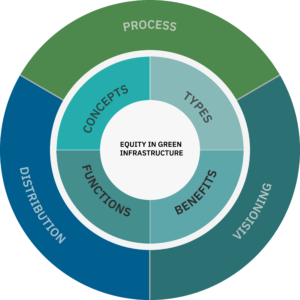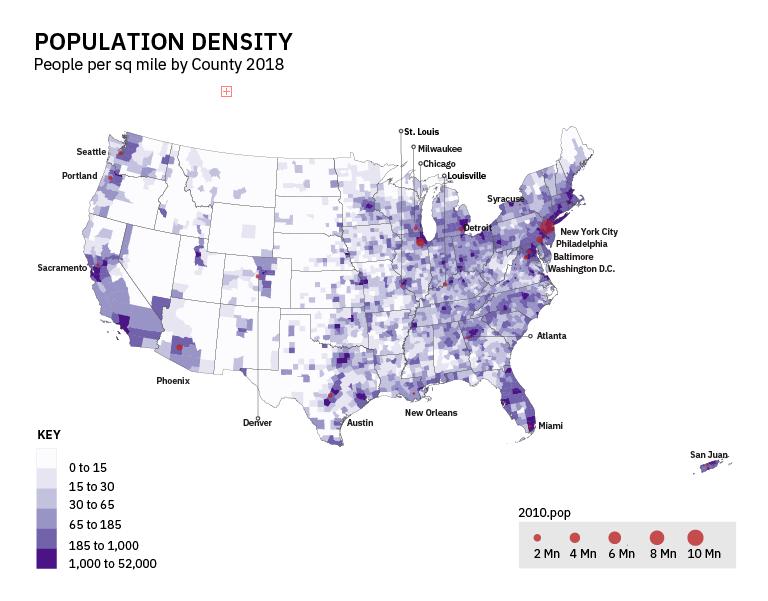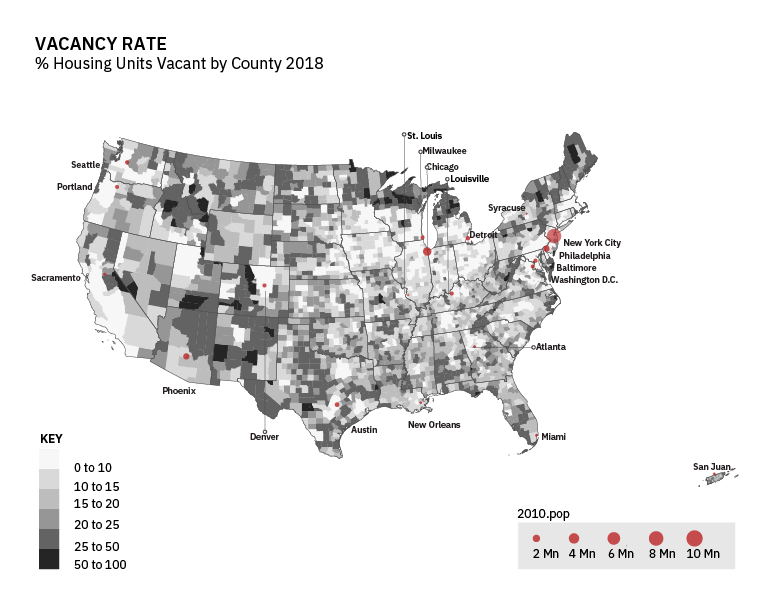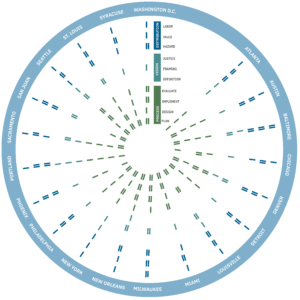Is Green Infrastructure a Universal Good?
Green infrastructure (GI) has become an important sustainability and resilience strategy for US cities, but how can we ensure that investments benefit all urban residents? This web resource presents findings from an examination of 122 GI city plans in 20 diverse US cities with an aim to discover how best to improve the equity of GI through policy and practice.
Why Examine the Equity of Green Infrastructure (GI) in Urban Planning?
Four out of five people in the United States live in or near a city. Cities serve as regional, political, and economic hubs and face intersecting environmental and social challenges. Across the US, urban residents deal with sharp disparities in environmental quality and exposure to climate hazards. These inequities are inseparable from growing gaps in wealth, health, and housing security.
As cities make efforts to “green” themselves to address resilience and sustainability challenges, patterns of greening appear to replicate longer running patterns of uneven urban development caused by racist and oppressive legacies and current practices of city planning. At the same time, urban ecological infrastructure provides significant value for residents, can help to manage multiple environmental hazards, and is a vital part of life-sustaining community infrastructure. The degree of equity in GI planning, therefore, depends on who makes city plans for whom, how, and for what ends.
Developing a Green Infrastructure Equity Framework
Green Infrastructure (GI) refers to a system of interconnected ecosystems, ecological-technological hybrids, and built infrastructures providing contextual social, environmental, and technological functions and benefits. As a planning concept, GI brings attention to how urban ecosystems and built infrastructures function in relation to each other to achieve socially negotiated goals.
Our framework considers GI equity in three major ways. First, equity in GI city planning requires engaging with affected communities and having clear processes for community control over how initiatives are designed, implemented, and evaluated. Secondly, the guiding visions of city plans must be rooted in robust definitions of equity and serve larger goals of justice for marginalized and oppressed communities. Lastly, the multiple values of, the hazards managed by, and the labor required to realize and maintain GI must be understood in their spatial and social contexts.
Key Findings
Of the 122 city plans examined, over 90% seek to rearrange the values and hazards of urban landscapes affecting the distributional equity of GI. However, only one in four city plans discuss equity issues, and 1 in 9 define the term, with even fewer mentioning justice. Very few city plans acknowledge the potential negative impacts of uneven or disproportionate investment in greening, like green gentrification. Cities that utilize a broad conceptualization of GI in higher-level city plans appear to more consistently address equity concerns and coordinate relevant city initiatives.
Despite a growing emphasis on including affected communities within planning, city plans fail to achieve procedural equity by not specifying methods and processes for inclusive design, implementation, and evaluation. While some city plans focus on creating low-wage maintenance jobs in affected communities, they do not discuss ways to build community wealth through the many different forms of labor that GI requires. Also, given the importance of Traditional Ecological Knowledge (TEK) for managing landscapes, there are surprisingly few mentions of Native peoples, their ecological practices, or relationships with the land in the past or present.
Diversity of Cities Across the US
We selected 20 cities representing a diverse array of conditions, challenges, and population sizes. Our work represents all types of plans that address green infrastructure, and how those plans attempt to address equity concerns.
We also recognize that equitable green infrastructure planning must address intersecting challenges posed by social conditions, existing infrastructure, and environmental quality. Across the country, large disparities in income, population densities, residential vacancy rates, and rent burdens (when more than 25% of annual income is spent on rent) differentially impact urban residents' relationships with green space.
National Land Cover: Location and size of the 20 cities, showing their relationship to the regional land cover map of the United States. Land cover refers to the characteristics of land in any given location, simplified here to differentiate developed zones from forests and other vegetated areas.
Population Density: Population density drives the cost and efficiency of infrastructural services. Urban GI is a key component of maintaining quality of life and reducing infrastructure costs in dense urban areas.
Vacancy Rate: Vacant housing units can indicate declines in population, wealth, and well-being of residents, or an oversupply of unaffordable housing. In the first case, they require reinvestment in housing and can be important GI opportunities, in the latter, they indicate housing market failures.
Median Income: Incomes have become increasingly unequal in the United States over the last several decades. To understand the impacts of public policies like GI programs, median income is a better indicator than the average.
Data Sources: Population Density - calculated from American Community Survey 2018 five year survey - total population data per county, the same source for Vacancy, Income, and Rent Burden. Land Cover (2016) land cover from Multi Spectral Land Characteristics Consortium (https://www.mrlc.gov/)
Overview of GI and Equity in Current City Plans
Our study has uncovered a tremendous diversity of city plans utilizing the GI concept, though often in fragmented ways. Similarly, many city plans inconsistently engage affected communities. Despite emerging commitments to equity, and with few exceptions, GI city plans do not consistently define or address equity concerns and are largely silent on the inequitable distribution of hazards to be managed by GI, and the potential disservices of uneven urban greening, including green gentrification.
Insights and Recommendations
Planning equitable Green Infrastructure requires a more diverse conceptualization of GI to capture all of its potential services and disservices. Ultimately, procedural equity determines how plans can address persistent inequities and injustices. This requires new forms of genuinely democratic neighborhood and city-level decision-making to produce visions for equitable GI systems that will build lasting value and manage emergent environmental hazards.
1. Use Broad GI Concepts to Guide Meaningful Coordination
Some cities employ the GI concept to coordinate disparate planning efforts, and yet planning for green infrastructure remains fragmented across most cities. Such fragmentation treats GI primarily as single-purpose single facilities rather than as a cohesive infrastructure system, limiting opportunities to address equity issues. To provide greater clarity, cities should embrace a broader more cohesive definition of GI, and use that conceptual framework to guide the development of specific ‘greener’ systems such as ‘green stormwater infrastructure’ or ‘green transportation infrastructure.’
Such an approach can improve urban ecological planning, support the greening of grey infrastructure systems to eliminate health burdens and ecological degradation from pollution, and create well-paying jobs. A major obstacle for such an approach stems from current EPA water pollution regulations encouraging plans to use the terms green infrastructure and green stormwater infrastructure interchangeably.
A concept of green infrastructure that includes land use and management alongside specific facilities is currently beyond the regulatory authority of the EPA. Paradoxically, cities are more likely to cost-effectively comply with EPA regulations by holistically managing their green infrastructure systems. In effect, cities must lead on innovation until the agency clarifies its guidance. Environmental advocates should push for legislative clarification at the city, state, and federal levels on green infrastructure approaches that address land use, management, and existing infrastructure systems.
2. Have Clear and Robust Definitions of Equity Emphasizing Processes
By managing urban hazards and providing multiple values to residents, Green Infrastructure will always have equity implications. Planners must accept this and clearly define equity, including transparent and meaningful involvement, ownership, and review of plans by affected communities. This type of community led planning requires community labor and should be fairly compensated.
Planners must also be aware of the relationship between planning and historical and ongoing injustice. Equity and governance are closely intertwined. Thus, alternative models of owning and governing land (e.g. limited equity coops, community land trusts), and economic and political systems need to be more deeply explored. Without transforming the underlying injustices in cities, it is unlikely that more participatory planning and a greener urban environment will lead to lasting equitable outcomes for marginalized communities.
3. Move from Participation to Democracy, and Plans to Planning Cycles
The GI planning life cycle includes ongoing processes of planning, designing, implementing, and evaluating projects. Plans often expressed intention to involve communities more closely in their creation, yet lacked substantive mechanisms for engaging communities throughout the planning life cycle, often appearing to manufacture consent. Planners must move beyond a framework of minimally required consultation and build participatory processes and good governance through deeper and supported engagement between city agencies and residents. Such efforts should recenter decision-making power with communities. Examples of such recentering include participatory budgeting, community oversight of public agencies, and compensation of communities for involvement in planning exercises.
This type of democratic planning requires upfront investments of time, energy, and financial resources to build authentic relationships and establish forums for expressing concerns and collectively determining paths forward which need to be binding on municipal agencies. Cities and states should take the lead on building procedural equity into their planning processes in the absence of strong federal leadership or appetite to enforce Title VI provisions for federally funded infrastructure projects. Current federal proposals to invest in urban infrastructure, including green infrastructure, should support the creation of robust community led planning at multiple levels.
Explore Findings by City
To explore more detailed city and plan level findings, follow the links below. We identify promising approaches and plans that honestly discuss the challenges facing equitable GI, despite the widespread failures to address equity concerns. There are numerous city-level opportunities to improve the equity of GI planning and its outcomes even with the general lack of mechanisms for cohesive and integrative Green Infrastructure planning.
Cities
Next Steps
Our analysis sought to understand the broad parameters of how Green Infrastructure and Equity issues are defined, discussed, and operationalized by city planners and agencies. Our next steps include a deeper investigation of how equity concerns discussed in plans are operationalized (if at all) within specific GI programs.
Resources
In addition to the materials on this web page, we offer some ancillary resources and publications. These include public-facing shorter communications, reports containing raw data, and peer-reviewed literature containing supplementary information supporting our analyses.
A public access repository of all 122 urban plans from 20 US cities analyzed, along with key metrics for each plan organized in a spreadsheet.
Peer-reviewed publications, blog articles, and other writing produced by the team related to this study.
Other organizations and initiatives working on equitable green infrastructure nationally or within study cities.






























